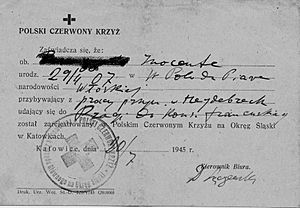Heydebreck-Cosel facts for kids
Quick facts for kids Heydebreck |
|
|---|---|
| Part of Auschwitz III-Monowitz | |
| Located in Upper Silesia | |

1945 Heydebreck card
|
|
| Site history | |
| Battles/wars | Oil Campaign of World War II |
| Events | 1945-01: Soviet occupation Post-war: Area recovered by Poland |
Heydebreck was an area in Nazi Germany that had several important facilities during World War II. These included camps for prisoners of war (POWs). One such camp was called Arbeitskommando E711A. Another was Bau und Arbeits (BAB) camp 20, which meant "Building and Labor" camp. This camp was later renamed E794 in November 1944.
About 5 kilometers (3 miles) west of Heydebreck was a place called Cosel. In the Cosel district, there was a subcamp of Auschwitz III, known as Monowitz. This subcamp was active from April 1, 1944, to January 26, 1945. In early 1944, around 800 POWs from Monowitz were moved to chemical factories in the areas of Blechhammer, Cosel, and Heydebreck.
Contents
Heydebreck's Role in World War II
Heydebreck was very important during World War II because it had many chemical factories. These factories produced materials vital for the war effort.
Chemical Factories and Production
The chemical facilities at Heydebreck made different kinds of products. One key factory was a Bergius hydrogenation plant. This plant could produce about 3,300 tons of fuel each month. Other important plants included:
- A Kybol plant
- A Methanol plant
- A Nitrogen plant
- A Butanol plant
- An Oppanol plant (which made a type of rubber)
- A Tanol plant
The Oil Campaign of World War II
Because of its important chemical factories, Heydebreck became a major target in the Oil Campaign of World War II. This campaign was a series of attacks by Allied forces (like the United States and Britain) to destroy Germany's fuel and chemical production sites. The goal was to weaken Germany's ability to fight the war. Heydebreck was first bombed by Allied planes in June 1944.
Post-War Events
After the war, events that happened at Heydebreck were investigated. For example, a shooting involving British prisoners of war was studied to understand what occurred during that time.
Images for kids


